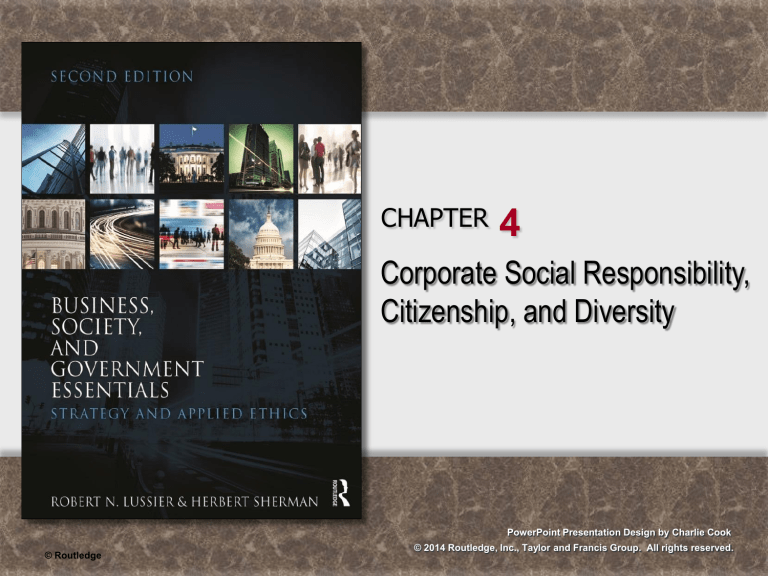Chapter 4

© Routledge
CHAPTER
4
Corporate Social Responsibility,
Citizenship, and Diversity
PowerPoint Presentation Design by Charlie Cook
© 2014 Routledge, Inc., Taylor and Francis Group. All rights reserved.
Learning Outcomes
After studying this chapter, you should be able to:
1.
Compare and contrast corporate social responsibility, citizenship, and social performance
2.
List the reasons for and against corporate social responsibility
3.
Characterize the three levels of corporate social responsibility
4.
Describe the five stages of corporate citizenship
5.
Compare the motivation and activity for corporate social responsibility
(CSR) and corporate social performance (CSP) and the social audit
6.
Describe the Equal Employment Opportunity Commission (EEOC)
7.
Define key terms in the chapter.
© Routledge
Corporate Social Responsibility and Citizenship
Corporate Social
Responsibility (CSR)
The firm’s conscious effort (enlightened self-interest) to operate in a manner that balances all stakeholder interests.
Corporate
Citizenship
Includes the firm’s social responsibility, responsiveness, and performance.
© Routledge
Corporate Social Responsibility (CSR)
Arguments for
Social Responsibility
1. Being socially responsible promotes business long-term self-interest.
2. CSR improves business value and reputation —public sentiment.
3. Society expects business to be socially responsible.
4. Business is responsible for correcting the social problems it causes.
5. CSR discourages government regulation.
Arguments against
Social Responsibility
1.
A firm’s sole responsibility is to maximize profits while obeying the law.
2. The cost of CSR is passed on to stakeholders.
3. Less socially responsible competitors may gain a cost advantage.
4. A firm involved in social issues can lose focus on operating as effectively as possible.
5. Dealing with social problems is the job of the government, not business.
© Routledge
Figure 4.1
Arguments For and Against Corporate Social Responsibility
© Routledge
Figure 4.2
Levels of Corporate Social Responsibility
Benevolent
CSR
Focus on profitability and helping society through philanthropy.
Ethical
CSR
Focus on profitability and going beyond the law to do what is right, just, and fair.
Legal
CSR
Focus on maximizing profits while obeying the law.
© Routledge
An Overall Approach to CSR
The Situational
Approach to CSR
© Routledge
Legal
CSR
Ethical
CSR
Benevolent
CSR
Figure 4.3
Stages of Corporate Citizenship
Stage 5. Transform
Change the game (Unilever)
Stage 4. Integrated
Partnerships, triple bottom line
(AT&T)
Stage 3. Innovative
Stakeholder management (Baxter and ABB)
Stage 2. Engaged
Philanthropy, social issues
(Chiquita and Nestlé)
Stage 1. Elementary
Profit (GE)
© Routledge
Benefits of Corporate Citizenship
Advantages of CSR
Enhanced reputation
Customer loyalty
Better employee relations
Awards and recognition
© Routledge
Stakeholders and the Triple Bottom Line
Social
Performance
Financial
Performance
Environmental
Performance
Overall
Performance of the Firm
© Routledge
Corporate Social Performance (CSP)
Assessing CSR and responsiveness
CSP reporting and social audits
Global social audit standards
Socially responsible investing
© Routledge
Diversity
•
Diversity
The degree of differences among members of a group or an organization.
•
Protected classes/groups
Groups legally protected by EEO laws from workplace discrimination include: race/ethnicity, gender, age, ability, religion, and others.
•
The Equal Employment Opportunity
Commission (EEOC)
Created in 1964 as the major federal agency to administer and enforce job discrimination laws to provide equal employment opportunity for all.
© Routledge
Discrimination in the Workplace
Workplace
Harassment
Includes slurs, derogatory comments, or other verbal or physical abuse that creates an intimidating, hostile, or offensive work environment or interferes with an employee’s work performance.
Sexual
Harassment
Occurs when any employee experiences unwelcome sexual advances or when on-the-job conditions are hostile or threatening in a sexual way.
© Routledge
Figure 4.4
Employment Laws and Executive Orders
Law or Executive Order Description
Equal Employment Opportunity
Title VII of the Civil Rights Act of 1964
Civil Rights Acts of 1972, 1991
Equal Employment Opportunity
Act of 1972
Executive Order 11246 of 1965 —
Affirmative Action
Prohibited discrimination in all areas of the employment relationship (hiring, compensating, promoting, discharging, and other aspects) based on race, religion, color, sex, or national origin. It also made racial and sexual harassment illegal.
Civil Rights Amendments provided possible compensation and punitive damages for discrimination.
Gave greater power to the Equal Employment
Opportunity Commission (EEOC) to combat discrimination.
Mandated affirmative action for all federal contractors and subcontractors to accelerate the movement of minorities into the workforce.
Companies doing business with the government were given preferential treatment if they had set employment percentages and quotas for minorities.
© Routledge
Figure 4.4
Employment Laws and Executive Orders
Law or Executive Order Description
Equal Employment Opportunity (cont’d)
Age Discrimination in
Employment Act of 1967
Rehabilitation Act of 1973
Americans with Disabilities Act of 1990 (ADA)
Prohibited age discrimination against people older than 40 and restricted mandatory retirement.
Prohibited discrimination based on physical or mental disability.
Strengthened the Rehab Act to require employers to provide “reasonable accommodations” to allow disabled employees to work and to provide access to facilities (ramps, elevators, rest rooms). ADA also required transportation systems and communication systems to facilitate access for the disabled.
© Routledge
Figure 4.4
Employment Laws and Executive Orders
Law or Executive Order Description
Compensation (salary and benefits)
Equal Pay Act of 1963
Pregnancy Discrimination Act of 1978
Family and Medical Leave Act of 1993
Required that men and women be paid the same for substantially equal work.
Prohibited discrimination against women because of pregnancy and childbirth. Prior to the act, employers could exclude health coverage to pay the cost of prenatal care and childbirth.
Required employers (with 50 or more employees) to provide up to 12 weeks unpaid leave for family
(childbirth, adoption, eldercare) or medical reasons.
© Routledge
Diversity and Minority Progress
Work and Jobs
100%
90%
80%
70%
60%
50%
40%
30%
20%
10%
0%
70%
85%
80%
14%
11%
5%
Percentage of Workforce
African American
7%
5%
4%
8%
4%
9%
Management Jobs
Hispanic Asian/Pacific
Professional Jobs
Caucasian
© Routledge
Benefiting from CSP
Business Nonmarket and Market Strategies
Information strategies that foster a positive view of the firm
Societal strategies that will gain a strategic advantage for the firm
Political and legal strategies that help the firm avoid legal and ethical problems
© Routledge
Key Terms
benevolent CSR cause-related marketing corporate citizenship corporate reputation corporate social performance (CSP) corporate social responsibility (CSR) diversity ethical CSR harassment legal CSR levels of CSR protected groups sexual harassment social audit triple bottom line
© Routledge







